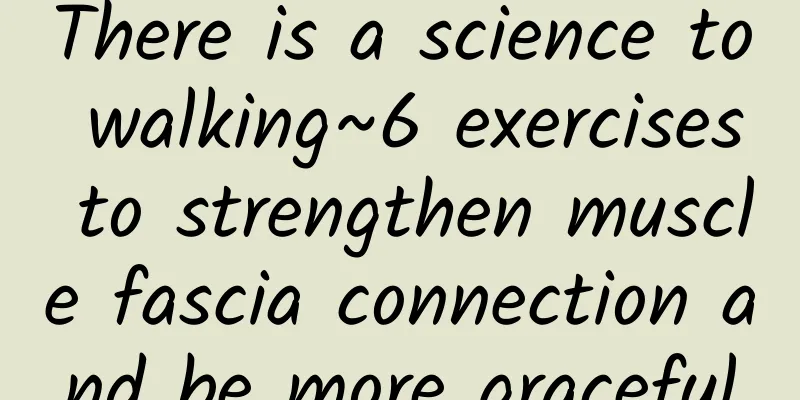There is a science to walking~6 exercises to strengthen muscle fascia connection and be more graceful

|
I really like to observe the coming and going of all kinds of people while waiting for a flight. Airports are the best places to watch people walking. Most people walk with a clear goal in mind, like walking quickly toward the boarding gate, running after their children, etc. Some people are more leisurely, but walk slowly with their eyes fixed on their phones. In other words, most of the time when we walk we are moving on automatic pilot, without any awareness. Because of the unconscious state, the legs from the heels and knees all the way to the hip joints and buttocks are often almost unconnected, and the muscles and fascia are rarely activated. The reasons behind this may be due to lifestyle, genetics, exercise methods, or lack of exercise. In modern times, the shoes we choose can also affect the shape of the fascia in the lower body. The more serious situation for most people is that they feel very tired and strenuous when walking, as if they are dragging a big stone. This is because some muscles "fall asleep" and the outer membrane covering the fascia tightens and adheres, such as the gluteus maximus and latissimus dorsi. As a result, the body cannot use the energy generated by the rebound when the fascia stretches, and the muscles can only use the high-cost method of consuming calories to push the body forward. That is to say, nature has given us the instinct to walk without consuming almost any energy, but we have lost this gift (fascia tissue can return up to 93% of the energy), and have gained various pains and discomforts. This chapter will include three exercises designed to further strengthen the connection between muscles and fascia. Please stay aware as you practice. You can do this once or twice a day, or even better, incorporate it into your daily activities to help you become more coordinated with your breathing, posture, and movements. 【Lie down and walk】 Purpose: Ideal walking is a smooth and efficient integration of related muscles and fascia groups, but in reality such connections are always lost to some extent. Through this exercise, you can strengthen your awareness and learn the connection from the soles of your feet to the top of your pelvis and lower back when walking. step: (Photo provided by Times Culture) ①Lie on the floor or yoga mat. You can fold a towel and place it behind your head, which will be more comfortable. Lie down comfortably for about a minute, then start counting your breaths, with the inhalation and exhalation lasting about three to four seconds each. Lasts four minutes. (Photo provided by Times Culture) Tips: If you feel discomfort in your lower back, you can use a pillow, cushion or blanket to raise your knees and relax your lower back. (Photo provided by Times Culture) ②Bend your knees and place your feet on the mat. (Photo provided by Times Culture) ③Lean your legs to one side, then switch sides, and repeat several times. Return your legs to a neutral position. (Photo provided by Times Culture) ④ Lie down with the upper part of your buttocks on the ground, and imagine that you are starting to walk with your buttocks. When you walk with your hips, your knees move with your legs: when the right hip is lifted as if you were "stepping forward", both knees move slightly to the left; when the left hip is lifted, the knees move to the right. Practice this for two minutes. Focus of awareness: When walking on your right hip, in addition to swinging your leg to the left, the outer edge of your right heel will leave the floor; when walking on your left hip, the outer edge of your left heel will leave the floor. (Photo provided by Times Culture) ⑤ Return your legs to the neutral position again. Now imagine that the soles of your feet are glued to the floor and you are walking on your hips again. Start with your right hip first. You will find that you cannot move as freely as in step 4. Then switch to walking on your left hip. Repeat this step for three minutes. Focus of awareness: With the soles of your feet glued to the floor, you can feel the muscles in your outer right hip and right thigh stretching. Feel whether the stretch and effect are the same on both sides of your hips. ⑥ Return your legs to a neutral position. Walk on your hips again, but this time with both feet free, starting with your right hip and then moving to the left for two minutes. Focus of awareness: When the feet are not firmly anchored to the ground, the pelvis will swing noticeably from side to side. Notice in particular that as you step out from your right hip, you will feel the lifting motion in your right lower back, from your right hip joint to the outside of your right leg. The same is true when stepping with the left hip. Tips: Once you become familiar with the feeling of the connection from your hips to your feet, you will notice the degree of connection and activation of your entire leg from your hips to your heels when you walk upright. Some people may experience pain around the SI joint due to stiffness in the gluteus maximus. In the previous exercises, if your feet are not on the ground, then your pelvis, legs, and lower back need to swing forward, pushing one side of the body forward at a time. Such unstable movements place unnecessary strain on the coccyx and sacroiliac joints. If you notice that you have trouble walking, tire easily, or have particular muscle aches, see your doctor for an evaluation and treatment. This article is from Times Culture "Move and find the joy of the body" |
<<: Lose weight without starch? Nutritional imbalance may lead to leucorrhea and acne
Recommend
Can’t lose weight? The culprit turned out to be excessive body fat! Don't do these NG things
You have tried various weight loss methods, but y...
Common surgical procedures for treating benign ovarian cysts
Surgery is an effective method for treating benig...
How to prevent adnexitis?
Women are most painful when they suffer from gyne...
Several symptoms that need to be paid attention to in the early stage of ectopic pregnancy
A healthy baby requires constant attention to the...
How can menopause be cured?
When menopause occurs in female patients, they wi...
Why does hydatidiform mole occur?
Why does hydatidiform mole occur? Speaking of hyd...
Experts talk about the key points for women to prevent uterine fibroids
Uterine fibroids usually have the highest inciden...
1.8 million metric tons of food waste produced annually! Stack up 1017 Mount Everests
According to statistics, for every 5 mouthfuls of...
How to treat pelvic effusion completely
I often had unbearable back pain, so I went to se...
Can I get pregnant if my hyperprolactinemia has dropped?
Many people have heard of hyperprolactinemia and ...
How to confirm ovulation bleeding
Ovulation bleeding usually occurs in the middle o...
7 weight loss foods to help you lose weight quickly
The following 7 kinds of weight loss foods are su...
What is the cause of female cervical erosion? 3 treatments for female cervical erosion
Women are fragile. If they don't take care of...
Can abortions five years ago be detected? Women who want to have an abortion must know these common sense
Everyone makes mistakes, after all, no one is a s...
How to treat and maintain pelvic inflammatory disease? Timely treatment is required
If a woman has pelvic inflammatory disease, she n...









